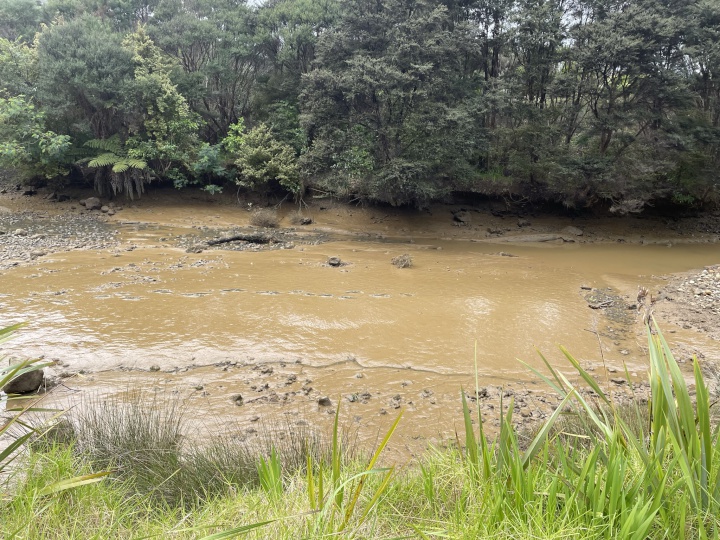Watercare to improve clarity of water in lower western dams
Watercare to improve clarity of water in lower western dams following last week’s storm
 ;
;Stream below Lower Huia Dam. This photo shows the stream below Lower Huia Dam after the storm. As with the dam, sediment has washed into the stream.
Last week’s torrential downpours caused large-scale landslides in Auckland’s Waitakere Ranges, pushing sediment into the water storage dams. In response, Watercare will open valves on its lower dams for a short period later today to release some of the murkiest water.Watercare chief operations officer Mark Bourne says opening the free discharge valves at Lower Huia and Lower Nihotupu dams should help to improve the quality of the water within the water supply lakes.
“When we inspected the area last week, we identified significant landslides in our water catchments, some of which have blocked roads, taken out mature trees and sent clay-coloured run-off into our water supply lakes.
“This means turbidity readings in all of our western supply lakes are much higher than normal. Before the storm, levels were about 2 or 3 NTU (nephelometric turbidity units). Samples taken at different depths of Lower Huia’s lake have found the water at the bottom is the dirtiest, with turbidity readings up to 500 times greater than normal.”
Bourne says the operations will be carried out under existing consent conditions, adhering to limits on flow rates and duration. Watercare normally times the free discharge operation for spring when lake storage levels are traditionally highest.
“Currently, the western dams are full and have excess water flowing down their spillways. We’d prefer the excess water to be released from the bottom of the dams than the top, because the water at the top is of better quality.”
Water will be released from each dam for no longer than four hours, with Watercare’s team on site to monitor water quality and safety during the operation.
Huia Water Treatment Plant is currently treating water from Upper Nihotupu, Lower Nihotupu and Lower Huia dams. Upper Huia Dam has fared the worst in terms of water quality, and with concerns that its watermain may have been shifted by a landslip, Watercare has taken this dam out of service.
“While the water coming into the Huia Water Treatment Plant is not as clear as it normally would be, our robust treatment processes mean there is no change to the quality of the treated water that leaves the plant. It is absolutely safe to drink,” Bourne says.
“Our staff are actively monitoring changes in the quality of the water flowing into the plant to ascertain if our treatment processes need to be adapted accordingly.”
Had there not been dams in the area, the material from the slips would have washed directly into the Manukau Harbour, instead of being released through a controlled operation.
Before the storm struck, Watercare had been running the Huia plant at minimum flow – producing between 50 and 55 million litres a day. Given the deterioration in water quality, it is continuing to run the plant at its minimum output.
The Waitākere Water Treatment Plant was taken out of service for 24 hours immediately after the storm but has since been treating water as normal from Waitākere Dam.
Notes
The operation will be carried out between 1pm and 4pm.
The opening of the valve will have minimal impact on the depth of the stream. This means the operation will not compromise the safety of people who are in the vicinity of the stream. However, Watercare will provide clear signage around the area, informing passers-by of the planned operation.
- The water being released is not polluted but will contain sediment as a result of the landslides.


 Gordon Campbell: On The Trump Upside, And Peters Persecution Of Trans People
Gordon Campbell: On The Trump Upside, And Peters Persecution Of Trans People Save the City-to-Sea Bridge: Join on Sunday afternoon to save Wellington’s City-to-Sea Bridge
Save the City-to-Sea Bridge: Join on Sunday afternoon to save Wellington’s City-to-Sea Bridge New Zealand Defence Force: Second World War Veterans Receive Message From King Charles
New Zealand Defence Force: Second World War Veterans Receive Message From King Charles New Zealand Government: More Than 900 Health Graduates To Receive Financial Boost Through Bonding Scheme
New Zealand Government: More Than 900 Health Graduates To Receive Financial Boost Through Bonding Scheme New Zealand Police: Stacks Of Cocaine Unpacked In Mt Wellington
New Zealand Police: Stacks Of Cocaine Unpacked In Mt Wellington Te Pāti Māori: Te Pāti Māori Make Submission To Privileges Committee In Absentia
Te Pāti Māori: Te Pāti Māori Make Submission To Privileges Committee In Absentia PSA: PSA Forces Changes To Restructure Of Data & Digital And Pacific Health
PSA: PSA Forces Changes To Restructure Of Data & Digital And Pacific Health


